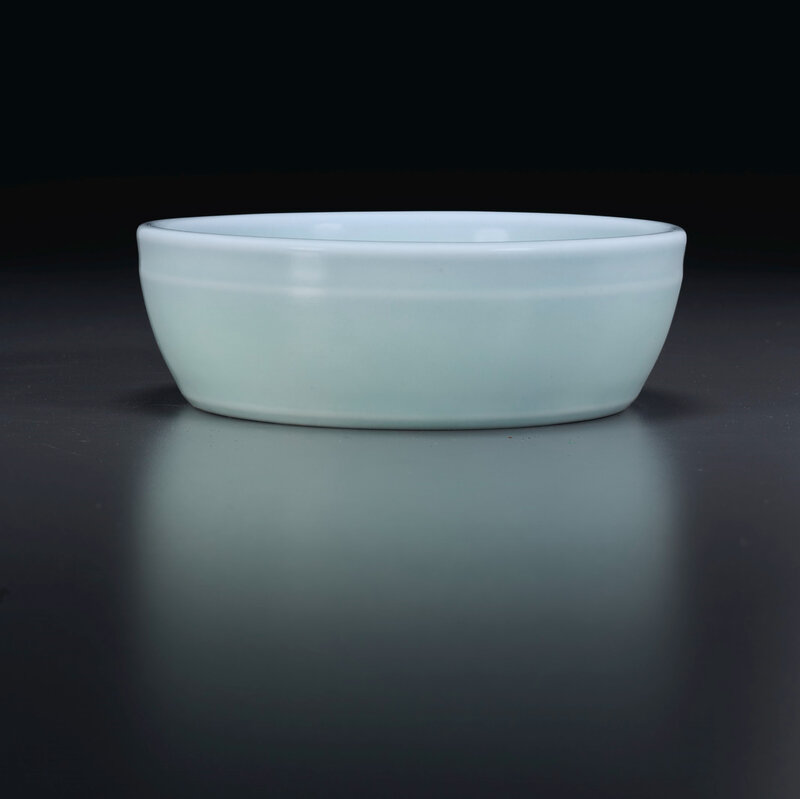A very rare Ru-type brush washer, Qianlong six-character seal mark in underglaze blue and of the period (1736-1795)
Lot 817. A very rare Ru-type brush washer, Qianlong six-character seal mark in underglaze blue and of the period (1736-1795); 5 1/8 in. (12.9 cm.) diam. Estimate USD 100,000 - USD 150,000. © Christie's Images Ltd 2020.
The shallow, rounded sides encircled by a subtle bow-string line below the mouth rim, and covered overall with an even, pale blue glaze that continues over the foot to cover the base where the nianhao is encircled by seven spur marks.
Provenance: The James and Marilynn Alsdorf Collection, Chicago, acquired prior to 1990.
Note: This rare and beautiful brush washer with Ru-type glaze is one of the most refined examples of Qianlong archaism. Northern Song Ru wares were greatly prized by the Qing emperors, who had them imitated by the potters at the imperial kilns at Jingdezhen. In this case, the potters have made every effort to faithfully reproduce not only the form and glaze of the original Northern Song Ru ware, but also aspects of its manufacture, which is apparent in the way the Qianlong washer has been fired. The foot and base are fully glazed and the vessel has been fired standing on tiny spurs, which have left small neat marks on the base. Firing on small spurs was one of the characteristics of Northern Song Ru wares.
This Qianlong washer relates closely in form to a slightly larger (15.9 cm. diam.) Northern Song Ru ware vessel in the collection of the National Palace Museum, Taipei, illustrated in Precious as the Morning Star: 12th-14th Century Celadons in the Qing Court Collection, Taipei, 2016, pp. 37-39, no. I-7. The Northern Song vessel has a flat base with no foot ring, and was fired on only five spurs, whereas the Qing-dynasty potters were not prepared to take such great risks as their Song counterparts, and used seven spurs to reduce the possibility of warping.
There is an additional feature on the exterior of the Qianlong vessel that does not appear on the Taiwan Northern Song washer. A fine 'bow-string' line has been applied to the exterior. It is quite possible that such 'bow-string' lines did appear on other Song Ru ware washers that have not been preserved. These lines were often added to Song Ru and Guan ware vessels that were made in forms taken from ancient bronzes. The raised lines represented the surface decoration on the original bronze. Such 'bow-string' lines can be seen, for example, on the Ru ware lian censer in the Percival David Foundation illustrated by Wang Qingzheng et al., in The Discovery of Ru Kiln - A Famous Song-ware Kiln of China, Hong Kong, 1991, p. 59, pl. 59.
Although production at the Ru kilns ended with the fall of the Northern Song dynasty in 1127, vessels of elegant, simple form covered with delicate bluish glazes continued in popularity. Related Guan ware washers have been excavated at the Laohudong and Jiaotanxia kiln sites in Hangzhou, Zhejiang province, which attests to the continued production of this type into the Southern Song dynasty. See, in addition, three Guan ware washers, of similar form and fired on spurs, but with a more pronounced crackle in the glaze, illustrated in Precious as the Morning Star: 12th-14th Century Celadons in the Qing Court Collection, op. cit., pp. 90-95 and 106-107, nos. II-11, II-12, and II-18.
In the fifteenth century potters at the imperial kilns at Jingdezhen were charged with the task of reproducing the soft bluish glazes on porcelain. In 1984, an alms bowl with Ru-type glaze was excavated from the Xuande strata at the imperial kilns: see Imperial Porcelain of the Yongle and Xuande Periods Excavated from the Site of the Ming Imperial Factory at Jingdezhen, Urban Council, Hong Kong, 1989, pp. 276-7, no. 97.
Both the Yongzheng and the Qianlong Emperors commanded porcelains to be made with Ru-type glazes. Several examples from the Yongzheng reign have been preserved in the National Palace Museum, Taipei: see Catalogue of A Special Exhibition of Ch'ing-Dynasty Monochrome Porcelains in the National Palace Museum, Taipei, 1981, pp. 129-31, nos. 77-79. The National Palace Museum also has preserved in its collection porcelains from the Qianlong reign with Ru-type glazes: see ibid., pp. 143-5, nos. 87 and 88.
A similar but slightly larger (6 3/8 in. diam.) Qianlong-marked Ru-type washer, formerly in the collection of J. M. Hu, was sold at Christie’s New York, 20 September 2005, lot 291. Another Qianlong-marked Ru-type washer, but with drum-nail bosses below the rim rather than a bow-string band, is illustrated by Wang Qingzheng, Treasures in the Royalty, The Official Kiln Porcelain of the Chinese Qing Dynasty, Shanghai, 2003, p. 333. For other Qianlong porcelains of various forms with Ru-type glazes preserved in the collection of the Palace Museum, Beijing, see The Complete Collection of Treasures of the Palace Museum - 37 - Monochrome Porcelain, Hong Kong, 1999, pp. 236-39, nos. 214-7.
Christie's. Sacred and Imperial: The James and Marilynn Alsdorf Collection Part I, New York, 24 September 2020

/https%3A%2F%2Fprofilepics.canalblog.com%2Fprofilepics%2F1%2F0%2F100183.jpg)
/https%3A%2F%2Fstorage.canalblog.com%2F03%2F02%2F119589%2F96711876_o.jpg)
/https%3A%2F%2Fstorage.canalblog.com%2F11%2F31%2F119589%2F94773502_o.jpg)
/https%3A%2F%2Fstorage.canalblog.com%2F20%2F83%2F119589%2F94772815_o.jpg)
/https%3A%2F%2Fstorage.canalblog.com%2F26%2F72%2F119589%2F75604929_o.jpg)
/https%3A%2F%2Fstorage.canalblog.com%2F59%2F60%2F119589%2F26458628_o.jpg)





/image%2F1371349%2F20240402%2Fob_f03735_865-1.jpg)
/image%2F1371349%2F20240402%2Fob_9318b6_130-1.jpg)
/http%3A%2F%2Fstorage.canalblog.com%2F05%2F67%2F119589%2F128676368_o.jpg)
/http%3A%2F%2Fstorage.canalblog.com%2F57%2F54%2F119589%2F127929957_o.jpg)